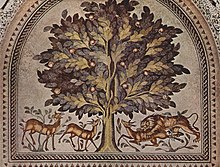User:James Flavio Ortiz/sandbox
Animals in Islamic Art
The depiction of animals serve numerous functions in Islamic art. Various animal motifs may work to serve as symbolic metaphors for human beings in a variety objects but their use may vary a great degree from object to object ultimately dependent upon context in which these figures are situated in. The depiction of animals may also serve the purpose of being decorative motifs, examples of the use of animals for decorative purposes can be found in textiles, ceramics, metal work, mosaics, and in general, a wide spectrum of Islamic artistic mediums. Furthermore, depictions of animals in Islam can potentially be a combination of both decorative and symbolic in their respective usage, e.g. royal tapestries with animal motifs used to cover furniture such as the "Double-Face Textile with a Tree of Life & a Winged Lion," hailing from Rayy, Iran circa the Early Islamic Period. In the instance of the "Double-Face Textile with a Tree of Life and a Winged Lion," the use of lions can serve as a great study for reoccurring animal motifs which are used as a representational link between the symbolic power of the lion in nature and the sultan's power. Which in term demonstrates a dual use in visually portraying a lions. [1]


Many animals are often represented alongside "vegetal" (Arabesque) patterns and are often found in an adorsed position (represented twice, symmetrically, and often side by side). Often times we can find these adorsed or flanking animals surrounding an actual visual representation of a tree, this seems to be a common motif. The "Tree of Life" mosaic found at the desert palace of Khirbat al-Mafjar built under Caliph Walid II's rule during the Umayyad period, is perhaps one of the most well known mosaics depicting animals in figural form in the Islamic world.[2] This particular mosaic was found in a private room of the desert palace which served as a bathhouse complex for the purpose of leisure. There is no religious context to this particular mosaic which explains the figural depictions of animals, under a religious context we would not see such figural depictions due to aniconism in the Islamic faith. In this mosaic we see a lion attacking a gazelle on the right side of the mosaic, and on the left side we see a depiction of two other gazelles casually grazing. Although their are multiple interpretations of this mosaic, one major interpretation seems to be that the actual physical depiction of the tree of life is a metaphor for the great and vast knowledge growing from the Islamic world. The lion attacking the gazelle is a borrowed motif from previous civilizations that is meant to represent Islam and the Islamic caliphates power as continuing the legacy of the great civilizations the preceded them (e.g. Mesopotamia).[3] Another main interpretation is that this mosaic was a private erotic piece of art that depicted the caliphates sexual prowess, seeing as it was located in a private room of the bath complex. The entanglement of branches on the trees bearing fruit, the female gazelles grazing by the tree, and of course the lion (a stand in for the sultan) taking down his "prey" (a sole female gazelle), are all a testament to the sultan's (Walid II) reputation and exploits, which were well documented in the sultan's own writings.[3]
Actual physical animals or trophy pieces of deceased animals would sometimes be gifted to royal courts from one sultan to another sultan in the Islamic world. In some instances this exchange of animals as gifts would come from outside the Islamic world as well. There is a documented Instance for example of Charlemagne gifting a sultan a live animal (a living, breathing elephant to be exact). The general overarching Idea of the examples given above are that the use of animals as symbolic representations of humans, royal accoutrements, symbolic representations of power, etc. were not necessarily exclusive in their use. Instead, they could cross the entire gamut in terms of art and culture. There is a multitude of usage and meanings in the depiction of animals in Islamic art. The context could range from political, religious, decorative, etc. These animal representations in the Islamic are not static and tell countless stories.
References

This is not the sandbox where you should draft your assigned article for a dashboard.wikiedu.org course.
To find the right sandbox for your assignment, visit your Dashboard course page and follow the Sandbox Draft link for your assigned article in the My Articles section.

